11/03/2019
The project was originally geared toward handloading the 44-40 WCF cartridge. Most load data I’ve put together, and most I’ve seen, is based on relatively fast powder and short barrel carbines or handguns. With a SAAMI MAP of only 11,000 PSI, and an early Winchester lever action design, not a whole lot was going to happen at the muzzle and beyond.
It seemed as though stretching out barrel length to 24″ and going with a slower burn rate powder, the average pressure could be kept inside spec, but longer burn persistence should yield a higher velocity and make the Winchester 1873 a more competent firearm for deer season. For folks in search of a high performance carbine, chambered for the 44 Remington Magnum or that can handle modern 45 Colt high pressure ammo, there is the stout Winchester Model 1892 which locks up like a bank vault.
The difficulty I encountered was that the Model 1873 is history book turned rifle and the subject gun was too nice to push to the background while developing handloads. Subsequently, two parts were necessary. The first to address the firearm, the second to address handloading.
 We like to think that Browning, Garand, Stoner, Williams, etc. each respectively scratched his head until he had a purely original thought, then locked himself in a workshop to hammer on a chunk of steel and whittle on a piece of lumber until he was holding his fully functional progeny in his hands. It doesn’t happen that way, as even these firearm design super stars based their best on preexisting principles and prior inventions.
We like to think that Browning, Garand, Stoner, Williams, etc. each respectively scratched his head until he had a purely original thought, then locked himself in a workshop to hammer on a chunk of steel and whittle on a piece of lumber until he was holding his fully functional progeny in his hands. It doesn’t happen that way, as even these firearm design super stars based their best on preexisting principles and prior inventions.
There is very little new under the sun. Practical genius is a person’s ability to vastly improve prior discoveries or to put them into an original arrangement to serve a completely new purpose. If we were to credit only those who presented original concepts and principles with all inventions that followed, Isaac Newton would be credited as the inventor of the Colt Automatic Pistol and Robert Boyle would take the bow for the M1 Garand.
The Winchester Model 1873 is the result of the efforts of a number of people and the outcome of a number of circumstances, most which had not been foreseen at the onset. In fact, it took 25 years to advance Walter Hunt’s 1848 inventions from “Rocket Ball” ammunition and a lever action, “Volitional Repeater” to the Jennings rifle, to the Smith-Jennings rifle, to the Volcanic Rifle, to the Volcanic Pistol, to the Henry, to the Winchester Model 1866 and, finally, to the Winchester Model 1873.
From bore launched rocket projectile to centerfire 44 W.C.F. the firearm’s design was refined by Walter Hunt, Lewis Jennings, Horace Smith, Daniel Wesson, Benjamin Henry, Nelson King and Thomas G Bennett. The process was lead financed by George Arrowsmith, Cortland Palmer, and Oliver Winchester. It was manufactured by Robbins & Lawrence, Smith & Wesson, Volcanic Arms Company, New Haven Arms Company, and the Winchester Company. The rifle made an appearance during the Civil War, during America’s Western Expansion and at Little Big Horn in the hands of American Indians… to General Custer’s dismay1) 2)
In terms of scale of production: 3 Walter Hunt Volitional Repeaters, 1,000 Jennings patent firearms, 1,000 pistols by Volcanic Arms under Smith and Wesson, 3,000 Volcanic pistols and carbines from New Haven Arms, 13,0000 thousand rimfire Henry rifles from New Haven Arms, 171,000 Winchester Model 1866 rifles and 720,610 Winchester Model 1873 rifles from the Winchester Arms Company. Each succession was more popular and each more competently done.
During the Henry rifle’s last full year of production, 1865, New Haven Arms became the Henry Rifle Company, the result of a dissident shareholders’ take over bid. While Oliver Winchester was abroad on a product sales and promotion tour, his corporate secretary Charles Nott entered into a collaboration with Benjamin Henry. Misusing the intent of a power of attorney assigned by Oliver Winchester, they petitioned the Connecticut Legislature to change the name of the company to the Henry Rifle Company.
Beyond the appearance of a business betrayal, it was a poorly thought out strategy on the part of Henry. Winchester controlled directly and through alliances, a majority of the company’s stock. Oliver Winchester had personally invested $300,000 in the New Haven operation, recorded as secured loans. Oliver Winchester owned the New Haven, CT manufacturing facility where Henry rifles were manufactured and he owned at least half of the production equipment used to manufacture them. 1) 3)
When the dust settled, a new facility in Bridgeport Connecticut was opened as the Winchester Arms Company with Nelson King installed as factory superintendent. Nott was sent packing from New Haven Arms and Henry was left to his own devices and spending his time threatening litigation. Within two years, the books closed on New Haven Arms and all assets and intellectual property from Hunt to Henry were absorbed by the Winchester Company. King set out to overhaul the Henry design and to give the company its first Winchester rifle. It came in the form of the Winchester Model 1866. 1) 4)
The Winchester Model 1866 – The transitional Yellow Boy
The designation “Model 1866” was actually not applied until the introduction of the “Winchester Model 1873” when it became necessary to differentiate the two models. Prior to the Model 1873, the Model 1866 was referred to simply as the Winchester. Nelson King joined Winchester as Benjamin Henry departed and remained Winchester’s factory superintendent through 1875. Production of the Model 1866 continued through 1898, concurrent with the Model 1873, with a total of just over 171,000 units manufactured. It was popular with frontiersman and lawmen during the Great Western Expansion and it was popular with American Indians who labeled the bright brass receiver firearm, “Yellow Boy”.
The Model 1866 was a transitional model for Winchester. Nelson King’s patent addressed pronounced weaknesses in the Henry’s design at a time when lever action rifle competition was growing. The slotted magazine tube was closed to strengthened the tube and kept out dirt and debris that could cause the rifle to malfunction. The magazine could now be loaded quickly, and without rendering the rifle inoperable, from a gate on the right side of the rifle’s solid brass receiver. Where the Henry heated up to the point of being too hot to hold when fired rapidly, a wooden forearm was added to the Model 1866 to insulate a shooter’s hands from that heat. Finally, the rifle had a Breech Pin Snapper; the firing pin was split so it would strike opposing sides of the 44 rim fire for more reliable ignition. 4)
The Winchester Model 1873 – The end of the bronze age
The Winchester Model 1873 was produced on Thomas G Bennett’s watch, an engineer with broad firearm knowledge. Bennett joined the Winchester Arms Company in 1870 and became the company’s president in 1890. From 1888 to 1896 Winchester held half interest in Remington. For some period of time, Bennett served as President of Winchester and a Vive President of Remington, before Winchester divested itself of all Remington holding. Nothing to do with the subject rifle… just kind of fun to note as it seems every prominent person and company crossed paths at one point or another.
The Model 1873 was a significant advancement in the company’s firearms design. The action was strengthened to accommodate centerfire ammunition, a mortise cover was added to the receiver top to shield it from the elements and in 1884 the brass frame and receiver were replaced with a forged iron receiver with surface side plates. The rifle was initially introduced with a more powerful 44 W.C.F. (44-40). The 38 W.C.F. (38-40) was added in 1880 and the 32 W.C.F. (.32-20) in 1873. In 1884 a .22 rimfire version was introduced. The Model 1873 was offered as a 24″ barrel rifle, 20″ carbine and 30″ musket version. Short rifles were also manufactured in 20, 18, 16, and 14″ lengths. Rimfire models were discontinued in 1904. The Model 1873 ran until 1919 in centerfire form. Winchester continued to ship inventory until 1924. A total of 720,610 were manufactured. 2)
One of the reference books 4) credited William Wirt Winchester, Oliver Winchester’s son with the 1874 invention of a reloading tool sold very successfully as an accessory for the Model 1873’s 44 WCF cartridge. I do not doubt that Winchester designed a reloading product that sold well and promoted the sale of their rifles, however, reloading was an existing process well before 1874 for other firearms, particularly the large bore single shot rifles.
The Model 1873’s 44 W.C.F. offered a significant improvement over the Model 1866’s 44 rimfire cartridge, adding both range and power. Still, the 44 W.C.F. the lacked power of competitor’s big single shot rifles used by many big game hunters. Winchester’s solution came in the form of the Model 1876, a larger version of the 1873, which was initially chambered for the 45-75 W.C.F. with performance similar to the .45-70 Government. This was later expanded to include : .50-95 Express, 45-60 W.C.F. and the 40-65 W.C.F. The rifle’s run ended in 1897 with 63,871 sold, mostly into England, India, Africa, and Canada. These were the last of the non-John Browning lever action rifles and the last toggle lock designs. Our subject rifle is the current build of Winchester Model 1873 Short Rifles.
The Modern Model 1873
With the exception of the inertia striker design, the Model 1873 is a faithful reproduction of the original. Its fit and finish are excellent… a brilliant color case hardened finish receiver, buttplate, lever, and forearm cap with satin finished Grade II/III walnut stocks. Inletting is clean and precise. The trigger is crisp, creep free and pull is absolutely in keeping with a lever action rifle.

In the photo above, the hammer is down on an empty chamber. Under normal circumstances the rifle is carried and stowed with the hammer in the half cocked position. When the rifle is cycled, the hammer is fully cocked, then lowered to the half cock position unless shooting is eminent. There are no tang or cross block safeties.
|
Winchester Model 1873 |
|
| Manufacturer | B.C. Miroku |
| Item # | 534217140 |
| Type | Lever Action |
| Caliber | 44-40 W.C.F. |
| Mag Capacity | 13 |
| Barrel | Blued 24″ Octagon |
| Rifling | 1:36″ |
| Weight | 7.25 Lbs |
| Overall Length | 43.0″ |
| Stocks | Oil Finish Grade II/III Walnut |
| Hardware | Case Color Hardened |
| Length of Pull | 13.0″ |
| Drop at comb | 1.75″ |
| Drop at heel | 3.00″ |
| Rear Sight | Adjustable Buckhorn |
| Front Sight | MARBLE ARMS® GOLD BEAD |
| Drilled and Tapped | No |
| Trigger Pull | 5 Lbs. 8 Oz. |
| Safety | Half Cock Hammer |
| MSRP | $1,739.99 |
The carrier block is solid brass and inscribed with identification of the rifle’s chamber. In this case the .44-40 W.C.F.. The SAAMI spec by piezo transducer method sets a MAP of 11,000 PSI for the 44-40 W.C.F. Its velocity standard is 1,175 fps with a 200 grain bullet and 1,000 fps for the 225 grain bullet. SAAMI standard barrel length is 24″.
SAAMI 44-40 WCF bullet diameter is 0.427″ -0.003″/+ 0.0″. Current production Winchester groove/bore diameter is 0.4285″/0.4224″ which offers the potential of many popular 0.429″ bullets if cannelure grooves fall correctly for proper crimping and jackets can be found that are thin enough to expand at relatively low velocity.
As indicated by the barrel stamp, the Winchester Model 1873 is contract manufactured by Miroku of Japan. Miroku has been making sporting firearms since the 1920s and has a reputation for finely finished firearm. If the politics of big government and big labor are your primary concern, the Model 1873 will probably not make you happy. If firearm performance, fit and finish are how you assess the value of a firearm, you will definitely be pleased.
This combination of semi buckhorn rear sight with elevation slide and brass bead front post work. They are not much different than the originals and, if you are willing to invest the time and effort, proficiency will find these to be fast… well, pretty fast and precise within any practical range for the 44-40 W.C.F. cartridge.
A quick peek inside
Yes, it is a blued gun I photographed earlier. No, I’m not lazy, just efficient.
Only one screw holds the Model 1873’s side plates in place. With plates removed, the simple, sparse parts count design is obvious. While setting up to take pictures, I pulled the side places, tipped the receiver to one side and all of the parts fell out and into my hand. Normally that is cause for concern and reason to break out the assembly guide, but the arrangement of parts is so logical and there are do few, it only took a couple of minutes to get everything back in its proper place.
The Model 1873 utilizes a toggle – lock system. The stress of firing is transferred from the breech bolt to the aft forged steel receiver through a series of links and pivot pins. The safety catch, added to the design in early 1879, assures that the rifle in in full battery before allowing the rifle to be fired.
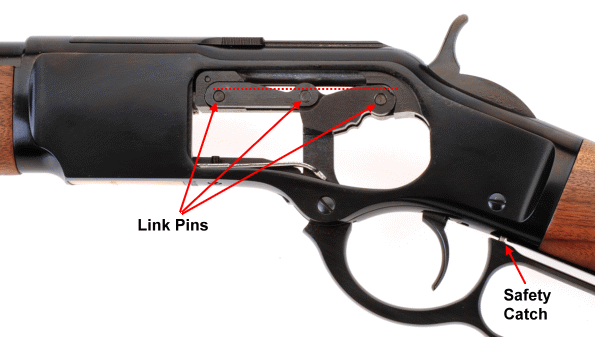
As indicated by the dotted reference line, the Winchester’s two forward pins are above the plane of the third pin. This assures that bolt force will be transferred back to the large boss at the rear of the receiver. The safety catch assures this orientation before the rifle can be discharged. A good number of reproduction rifles position the center pin slightly below the plane of the aft pin. This directs force downward to the lever upon firing rather than to the substantial boss at the rear of the receiver, which significantly reduced the strength of those actions.
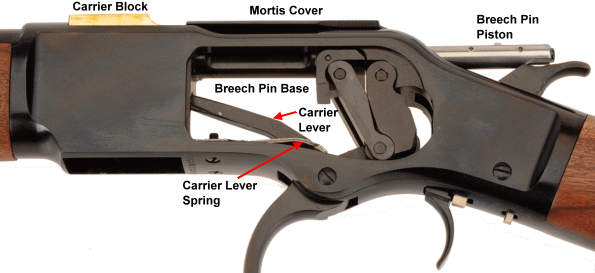
Cycling the lever back opens the mortis cover, pulls the breech bolt assembly aft, collapses the pinned link assemblies and the bolt cocks the rifle’s hammer. During this stroke, the carrier lever raises the carrier block with a fresh round into alignment with the rifle’s chamber. As the lever is cycled closed, the breech bolt assembly moves forward and charges the rifle’s chamber as the carrier block is lowered back down to receive another round from the rifle’s tubular magazine.
The Winchester 1873 with the carrier block up and the cartridge (no primer) is being driven forward into the chamber. The mortis cover opens, but does not automatically close when the rifle is cycled
Bottom line
The Current Model 1873 Sporter Octagon Color Case Hardened rifle is a tribute to the history of Winchester. For folks who like the personality of these classics, it is a good one to own, shoot and admire. The design will comfortably handle any of the available chambered cartridges: 357 mag/38 Special, 44-40 WCF and 45 Colt at standard pressure levels, but it is not a rifle to hot rod with pushed pressure ammunition. For the life of me, I can’t think why anyone would a historical rifle with a 11,000 PSI design when there are other Winchesters suited to that purpose.
As a practical matter, I can’t see the 24″ barrel being a hindrance. The boost in velocity gives the 44-40 WCF cartridge a meaningful pick up in kinetic energy and the long sight radius definitely helps use of those metallic sights. Part II with live fire and handload data following shortly, now that a useful handloading tool has arrived. More on that in Part II.
1) American Rifle: A Biography – Rose
2) The History of Winchester Firearms 1866 – 1992 Henshaw
3) Winchester Repeating Arms Company – Houze
4) Winchester, An American Legend – Wilson

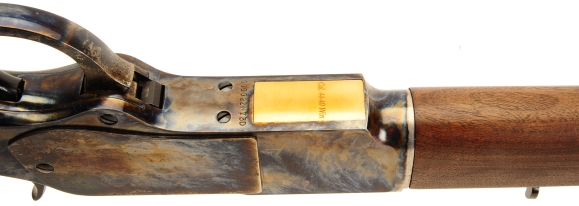
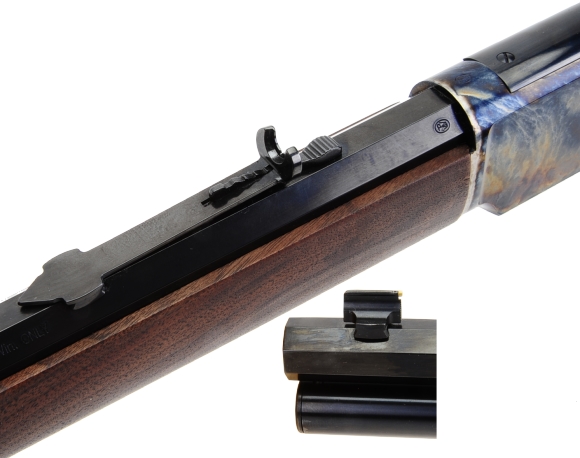
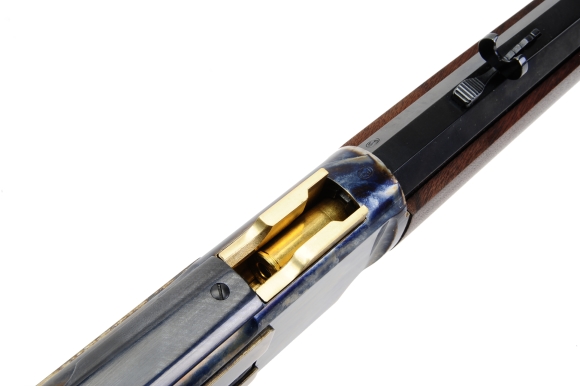
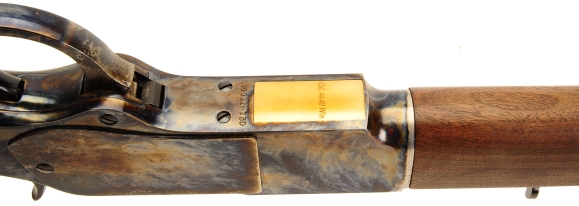
Email Notification